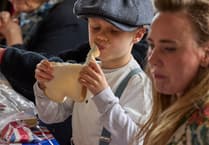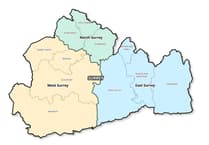TWENTY young farmers have spent two days learning about the art of hedge laying, working on a 10-year-old hedge that borders footpaths by The Rose and Crown pub at Upper Farringdon.
Their base was Norton Farm, which sits on the border of Selborne and Farringdon, and they instructed by Andrew Birnie, an expert in the ancient art of hedge laying, which is vital to keep our hedgerows in good shape to create habits for birds and small mammals.
Over the two days, and ignoring torrential rain on the Saturday, they worked on the 2.3 miles of the hedge to thicken it up and make its base a haven for small animals.
The project was set up by Kate Faulkner, Rob Nicholl and Laura Deane, who also provided hot soup and rolls in the barn at the farm for the farmers, six of whom came from Selborne, six from Alresford, and the others from farms at West Dean and surrounding villages.
On Sunday, Kate, Rob and Laura welcomed a team from the South Downs National Park who were returning to carry out a survey on harvest mice.
The team was inspired by naturalist Gilbert White, who lived in Selborne and who, on November 4, 1767, first identified harvest mice as a separate species after making a study in his garden and the surrounding fields.
Last November, with this local interest in mind, a group of farmers, together with rangers and volunteers from the South Downs National Park, set out to survey harvest mice on farms in and around Selborne.
This collaborative group, The Selborne Landscape Partnership, has been set up to approach conservation issues on a landscape scale with the aim of achieving wider ecological benefits than individual farmers working in isolation.
Under the guidance of Peter Thompson, of the Game and Wildlife Conservation Trust, they searched for the breeding nests described by Gilbert White as “a little round nest composed of the blades of grass or wheat found on stems of hedgerow plants”.
“During the winter months the mice vacate these summer residences and take cover in the base of tussocky grasses,” he said.
Armed with their newly-acquired knowledge, they set off into the fields with cameras and tape measures in search of nests. In around two hours, 29 harvest mouse nests were identified at Norton Farm.
With experts on hand to verify the finds, they were able to update the official records and confirm that the harvest mouse population is alive and well in Selborne after 159 nests were located in and around the village.
Today, the vast majority of modern-day farmers allocate areas of land for environmental purposes.
Kate said: “At Norton Farm, grass headlands have been established around all of the arable fields and approximately 2.3 miles of hedgerows planted within the past 20 years. These areas attract a variety of wildlife, and one of the species that we aim to help is the harvest mouse.
“I’m glad to say more harvest mice nests have been found here at the farm and the new hedge laying, which was a great success, will help establish more.
“Because hazel support stakes and binders from coppiced woodland were used in the hedge-laying process. The result will be a thicker and healthier hedge which will act as a haven for wildlife.
“So we were delighted that a team from the South Downs National Park came to join us on Sunday. The whole two days were hugely successful and our hedge laying will continue to provide a valuable habitat for birds and mammals.”





Comments
This article has no comments yet. Be the first to leave a comment.